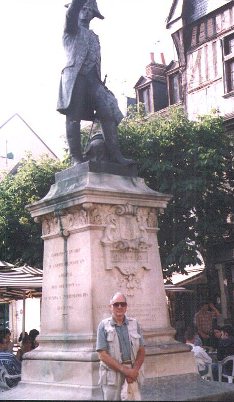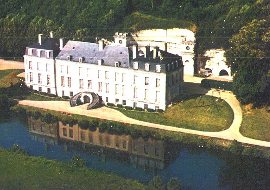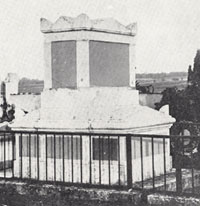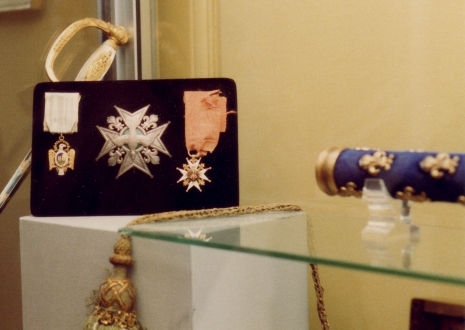Part I: EARLY YEARS
One of the most important foreign military commanders who fought for American Independence was the French General Jean Baptiste Donatien de Vimeur, comte de Rochambeau. Born at Vend�me on 1 July 1725, he was the third son of a family with a long military tradition which extended back to the crusades. His father was governor of the Ch�teau de Vend�me, southwest of Paris.
As the younger son, Jean-Baptiste studied for the clergy until his elder brother died. Then it was expected that he take up the family military tradition, and serve the family motto: Vivre en preux y mourir, �To live and die as a gallant knight�.
At age 15, Rochambeau was sent to Paris to attend the officers' academy. In a few months, he was off to the War of the Austrian Succession, which began between Prussia (with which France was allied) and Austria in 1740.
Rochambeau started his career as a junior cavalry officer (cornet of horse) in the Saint-Simon regiment and participated in operations in Bohemia, Bavaria and along the Rhine. He was 16 years old when he went with Bell-Isle's army to the walls of Vienna, and then with Marshal de Broglie to occupy Prague. At this moment, Frederick the Great pulled Prussia out of the war and left the French forces in eastern Europe over extended. The French were forced to make a mid-winter retreat while continuously harassed by Austrian light troops. During these frustrating conditions, Rochambeau proved reliable and aggressive. He once was reprimanded for attacking when he was being held in reserve.
Rochambeau was assigned garrison duty on the Rhine until promoted to captain in 1743, at the age of 18. Thereafter, he moved to court where his mother was a lady-in-waiting to the duchesse d'Orl�ans. In those times, court connections were essential for young officers to get opportunities to serve under the more favored commanders. Such assignments were critical for recognition and career advancement. Rochambeau became aide to duc d'Orl�ans and, with the duc, accompanied Marshal Saxe in the latter's 1746 Flanders' campaign.
In that campaign, Rochambeau served under Comte de Clermont at the successful siege of Namur, where Rochambeau distinguished himself during the siege on several occasions. His reconnaissance of the citadel was credited for the eventual capture of the city. Once in the city, Rochambeau showed bravery in the direct, on scene supervision to remove powder barrels from a burning magazine. Impressed by the young officer, comte Clermont asked the king's mistress, Mme. Pompadour, for permission for Rochambeau to buy a regiment.
At age 22 (1747), Rochambeau became colonel of the infantry regiment de la March. He was wounded by grapeshot in the battle of Laufeldt (2 July 1747) leading his regiment in a charge against the center of the enemy's line. Later, he served gallantly in the siege of Maestricht (1748). As recognition of his distinguished performance, Rochambeau was accorded the honor to ride alongside the king in military ceremonies.
Following the peace of Aix-la-Chapelle, Rochambeau sensed that his military career was at an end. At age 24 he married Jeanne Th�r�se Tellez d'Acosta, daughter of a wealthy merchant, and both retired to his estate at Vend�me.
Part II: SEVEN YEARS' WAR
With the start of the Seven Years' War (1756-1763), Rochambeau was again in military service. He served under the duc de Richelieu, and participated in the brilliant joint operation against Minorca. Rochambeau flawlessly directed the transport of siege artillery, the timely deployment of which was vital to the capture of Fort St. Philip at Port Mahon.
During the early phase of this siege, the French experienced considerable drunkenness among the troops. Rochambeau reportedly was responsible for a rather daring policy that no man should be permitted to take part in an assault who had been drunk the day before. This was one of many occasions were Rochambeau proved his skill at troop motivation. A sense of honor among one's comrades-in-arms and the constant probability of an assault the next day brought sobriety to the ranks. Following this successful campaign, Rochambeau was appointed brigadier general and received the Chevalier de St. Louis in 1756.
In 1757, Rochambeau served on the Rhine under the duc d'Orl�ans and Marshal d'Estr�es. Rochambeau was in a position to witness the jealousies among the senior French commanders that help to undermine the French military effectiveness in this war. Rochambeau kept himself apart from these inter-rivalries, and gained praise from the various contending senior French commanders. By the end of the year, he was promoted to major general.
He next was entrusted with command of the vanguard of an offensive into Hanover. At the border of the Harz mountains, Rochambeau bluffed the Fortress of Regenstein into surrendering. The capture of this strongly fortified town enabled the French to force an armistice upon the English and German forces in that region. Unfortunately, Frederick's victories at Rossbach (5 November 1757) and Leuthen (5 December 1757) turned the tide against the French and their allies.
In 1759, Rochambeau became commander of the crack Auvergne infantry regiment. He attempted to create a company of light infantry, or chasseurs, within each battalion. Rochambeau's concept was to create an elite unit among troops of smaller stature, emphasizing their quickness and agility in contrast to the grenadier units. Unfortunately, bickering jealousies between senior officers aborted this initiative. Nevertheless, Rochambeau's Auvergne regiment went on to distinguish itself at the Battle of Clostercamp in 1760. Rochambeau was wounded in this costly won victory, but his performance led to his promotion to Mar�chal de Camp (equivalent to major general) and his appointment to the powerful post of inspector general of infantry in 1761.
Following the 1763 peace treaty, a new French Minister of War, duc de Choiseul, introduced many reforms which Rochambeau supported and aggressively help implement. Rochambeau organized training camps, instituted a series of tactical exercises and maneuvers, studied the lessons of the last war, advocated extended field formations to minimize growing effectiveness of field artillery and instituted companies of chasseurs as standard in each line infantry battalion.
In 1771, Rochambeau received the Grand Croix de Order de St. Louis. He had gained a reputation of indifference to court intrigue and distanced himself from the inner circles surrounding the powerful royal mistresses, madames Pompudor and du Barry. As war ministers changed, with the death of Pompudor and the rise of du Barry, Rochambeau resisted attempts to revoke many of his recently implemented reforms. Royal mistresses disappeared with the accession of Louis XVI, and Rochambeau's professional integrity was rewarded when he was offered the position of Minister of War. He declined this offer and continued for a few more years to address badly needed military reforms.
Part III. AMERICAN REVOLUTION
By 1776, Rochambeau accepted the Governorship of Villefranche-en-Roussillon, and served under the comte de Vaux to prepare for an invasion of England. The objective was to take advantage of the English having to deploy a large part of their military to put down the growing rebellion in North America. The planned, so-called 'invasion' entailed occupying the Isle of Wright and raiding the Portsmouth docks by mid 1779.
Unfortunately, 1779 was not a good year for the French military efforts. The invasion of England, toward which Rochambeau had worked by fiercely training and equipping his troops, was cancelled. The effort collapsed due to inadequate French naval logistics, poor combined naval operations with the Spanish, and an outbreak of small pox. In the same year, Vice-Admiral d'Estaing deployed with a French naval squadron to the West Indies and the American continent, during which he participated in some very disappointing joint and combined military operations with the rebel colonists.
However, the French Treaty of Commerce (an eighteenth-century �lend-lease act�) was signed with the American colonies in February 1778 -- effectively being the first diplomatic recognition of the United States. France had committed itself openly for American Independence. There now existed a �new� French army (largely a result of Rochambeau's reforms and preparations) that was in a high state of readiness and had no immediate operational objective since the invasion of England was cancelled. This was the setting in 1780, when the marquis de Lafayette returned from America to contribute in planning the deployment of a major contingent of French forces to fight along side the American colonists. Besides suggesting a likely arrival port for the French forces in North America, Lafayette emphasized the importance to select a French expedition commander who would be sensitive to the challenges of working with the American leaders.
It was not surprising that Rochambeau was promoted to Lieutenant General and was assigned to command a planned expedition of over 7,000 men to aid the American rebels. In an most unusual gesture, the French Foreign Minister, Vergennes, directed that Rochambeau was to place himself subordinate to George Washington, and that the French troops were to be designated as �auxiliaries' to the American land forces. The operation was given the code name of Exp�dition Particuli�re and consisted of only 5,500 men when it sailed from Brest on 1 May 1780. It anchored off Newport, Rhode Island, 11 July 1780. Rochambeau came ashore the next day.
This was the beginning of Rochambeau's greatest military achievement, but one which often gets overlooked in histories, since the victorious results largely benefitted his allies and not his own nation. The significance is minimized by historians who seek to promote national heros. It is also ignored because it is a success story of such accomplished professional military skill that it did not produce the bloody, costly encounters that make for sensational reading in popular military history. Because the end came in a relatively pedestrian siege in 1781, the difficult situation confronting Rochambeau in 1780 is seldom recognized.
Rochambeau was in a precarious position when he landed on American shores in July 1980. His line of communications was 3,000 miles across an ocean dominated by the enemy's navy. He was campaigning in an unfamiliar land, allied with a rebellious, ill-defined faction of the enemy's people. His allies, themselves, had been enemies of France less than two decades previously. Equally distressing, Rochambeau discovered that the American army was far less prepared than even the worst reports received in Paris had indicated.
With professional dedication, Rochambeau dutifully placed his finely equipped and trained French forces under general George Washington's supreme command, and overcame American prejudices by tact, a modest charm, and wise demeanor. Rochambeau's personal influence was strongly reflected in the courteous conduct of his officers and the exceptional discipline of the French troops. Seldom in military history has a military leader exhibited such thorough command over the factors so critical to conducting coalition warfare.
Initial complications arose with impetuous zeal of Lafayette as liaison officer with Washington. However, Rochambeau corrected this problem with his famous, admonishing �father-to-son� letter to the young marquis. Rochambeau counseled Lafayette that it would be tempting to make a military show of force with the superb French forces he had, but that it was more important not to waste any of these limited resources on anything other than an important operation.
Rochambeau, although far more experienced than Washington as a military commander, served under Washington with the utmost respect and skill. The two commanders carefully formulated their grand strategy in a series of conferences. The Hartford Conference of 21 September 1780 was held in Connecticut, half way between the French encampment at Newport and Washington's headquarters near New York. Rochambeau resisted pressure to launch an immediate attack against the British strong defenses at New York. Rochambeau convinced Washington to wait for more forces (the over 2,000 men of Exp�dition Particuli�re that had to be left due to a shortage of sea-lift).
Unfortunately, the French government hesitated adding to the expedition. In Paris, doubts were surfacing about the American effort. A series of incidents caused concern: Benedict Arnold's defection, weakness of the Congress, bickering American agents in Paris and the difficulty the colonists were having keeping a sizable army in the field.
The French expedition went into winter quarters in Rhode Island. Rochambeau established his headquarters in Newport and settled into the social life with considerable success. The French military bands were a particular success at the many balls which Rochambeau hosted. He made his quarters in the Vernon House (now restored) a center of many gatherings where his officers met with the citizenry. Although the French officers were billeted among citizens, the troops were maintained in separate camps outside the city. Everything the French used (even the camping fields) was paid for with hard currency.
The French troops were commended by many for their amazing discipline, which reflects upon the quality of the commander. Rochambeau did not rely on the threat of harsh punishment but rather on anticipating the needs of his men and providing for them. He established what may be the first military newspaper in America. This and the many social activities were in response to the isolation his troops experienced in the unfamiliar surroundings of colonial America.
Early in 1781, the Americans pressed for the French to deploy on some excursions in the south, where up to this time British were meeting with little resistance. Although Rochambeau was leery of engaging in hastily conceived plans which would not decisively strike at the British, he did finally agree to send his small French fleet in a January raid into Virginia waters. However, at an early March Newport meeting with Rochambeau Washington pressed for a large force to deploy against Arnold in Virginia. A larger French naval squadron, with a contingent of French army troops, departed Newport on 9 March, but was prevented from entering the Chesapeake Bay, Virginia, after a 16 March naval engagement with a British squadron..
This was not a very promising start and Washington expressed his irritation with the French in a letter to his cousin, Lund Washington. Unfortunately, the British intercepted and published Washington's letter in a New York Tory newspaper. Rochambeau was obligated to confront Washington about the letter and accepted Washington's honest reply and apology.
In late March 1781, Rochambeau received news from Paris. There would be no more French troops sent to join his expedition, but Admiral de Grasse, with a fleet of about 30 ships, would be in the West Indies and might be made available for a brief time to assist allied land forces in North America.
Rochambeau discussed this with Washington at their 21 May 1781, Wethersfield Conference. Washington became more appreciative of the reason for Rochambeau's caution. It was imperative that this French force be used for decisive operations since it would be all that the French intended to provide.
The Two commanders discussed two options. One was Washington's long held objective of taking New York from the British. The other was a suggestion by Rochambeau to concentrate forces in the south against less formidable British forces. Both options needed naval support to succeed. While Washington's New York campaign was given priority, the concept for a campaign in Virginia began to take form. The allied generals in New York kept alert to developments in Virginia, were a small American army under Major General Lafayette was maneuvering against a larger British force under the experienced British General Cornwallis from late May through July.
In June 1781, Washington's American and Rochambeau's French forces joined at Philipsburg, New York. In July, Washington, Rochambeau and their key staffs performed joint reconnaissance of the British defenses. The allied commanders recognized that lack of naval support and more American troops prevented a serious attack against the British positions in New York. On 14 August, Rochambeau received word of de Grasse's intentions to be off the coast of Virginia in September. With this news, the Yorktown Campaign was set in motion. Washington immediately approved the largest overland, and part river transport, strategic movement in the war.
The French naval commander of the small fleet at Newport departed 25 August with the valuable French siege guns and provisions to join up with De Grasse. Unknown to the American and French forces in the north, De Grasse was nearing the Chesapeake Bay where he would anchor in Lynnhaven Bay on 30 August and off load 3,000 troops a few days later to assist Lafayette.
The Allies' overland march from New York began 19 August with deceptive northward moves which successfully confused the British forces at New York for days. En route south, some of the forces loaded on boats at Head of Elk, Maryland. Except for the wagon train, field artillery and cavalry [French hussars], the rest of the armies embarked on ships from, or near, Annapolis, Maryland. The strategic movement was made in remarkable time. By 10 September, Rochambeau and Washington (traveling entirely overland and separately from their main forces) were at Mount Vernon, Virginia. Soon after their departure from Mount Vernon, they received news that de Grasse had deployed back out to sea to engage a large British naval force. On 14 September, Washington and Rochambeau arrived at Williamsburg, Virginia, where they joined with American forces under Lafayette and French regiments that came with de Grasse's fleet. Also, it was learned that de Grasse had succeeded in driving the British fleet, under Admiral Graves back out to sea, leaving the now highly outnumbered British forces of Cornwallis' isolated at Yorktown. Swiftly, Washington and Rochambeau conducted a perfect textbook eighteenth-century siege. Trenches were dug largely under the supervision of French engineers. The presence of large French siege guns, which Rochambeau had brought with his expedition, were a devastating surprise to the British.
The British surrender (19 October) at Yorktown was the decisive military engagement Rochambeau had sought. Of course, many were not certain at the time exactly how decisive it was. Washington and Rochambeau immediately had to think about the next campaign. Washington hurried back north, while Rochambeau' forces remained in Virginia, Headquartered at Williamsburg.
Within the year, the peace negotiations advanced enough that the French called Rochambeau home. He met Washington in Philadelphia (July 1782). Later, they celebrated the anniversary of the Yorktown Victory at Washington's Hudson River camp. Rochambeau bid his final farewell with Washington at Newburgh, New York, and sailed from Anne Arundel , Maryland, 8 January 1783, arriving in France 10 February.
|
Part IV: FRANCE AND REVOLUTION

|
Rochambeau as a maréchal de France
(artist not identified) Portrait reportedly in the French Defense Ministry, Paris
|
Upon Rochambeau's return to France, Louis XVI awarded the French commander with the Cordon Bleu of the Order of the Saint Esprit. Rochambeau was assigned commander of the Northern District, and enjoyed the following four years of peace. He was active in the Society of the Cincinnati and exchanged a few letters with Washington. He even visited with Cornwallis during a twelve day trip to England in 1787.
By 1789, Rochambeau began to witness the disturbing disruptions of the on coming revolution in France. His first experience was with a mutiny of some army units at St Omer. Later, when his command changed to Alsace, he witnessed riots in Strasbourg following the fall of the Bastille. He saw army discipline eroding. Later, as commander of the Army of the North in 1790, he became greatly discouraged to see soldiers being encouraged to join political clubs.
In 1791, France was preparing for an attack by Austria. The French armed forces were much weakened by politicalization and the emigration of many experienced officers. A new Minister of War, Narbonne, made Rochambeau a Marshal of France (the last one of the ancien r�gime) and placed him in command of the Northern armies. Then Dumouriez replaced Narbonne as Minister of War and pushed for a war �to unite the country�. Finding the planning questionable and becoming increasing ill, Rochambeau resigned to return to Vend�me as �citizen Vimeur, named Rochambeau�. He found his home and grounds ravaged, friends killed, and the local village of Thor� hostile.
In spite of the growing anarchy, Rochambeau maintained a degree of patriotism. He admired the passionate enthusiasm of the arm�e en masse and how it kept twelve armies in the field, and repulsed foreign invasions despite civil war within France. In 1794, Rochambeau was arrested and taken to the Conciergerie in Paris. He was quite ill and, ironically, hospitalization delayed his appointment with the guillotine. Just days before Rochambeau's scheduled execution, Robespiere was overthrown and executed on 28 July 1794. Rochambeau was released on the 27th of the following October.
Following this harrowing experience, Rochambeau retired to his home in Vend�me. In 1796, he wrote his last letter to Washington. In 1801, he met Napoleon, and in 1804 was awarded the L�gion d'honneur. Rochambeau died at age 83, on 12 May 1807. He lived to see a great French military army bring spectacular, if transitory, military glory to France. He might have appreciated recognition of the small part he played in the development of that establishment. He probably did not foresee that his great military moment in history helped to establish a foreign democratic republic that would later repay its debt to France by sending its troops to France's assistance in two world wars.
The foregoing article has been significantly modified from the initial article published in the Journal of Early Modern Warfare, Gorget & Sash, III:4 (1990). Further information on the French military expedition in the American War of Independence can be obtained from Exp�dition Particuli�re Commemorative Cantonment, P.O. Box 137, Mount Vernon, Virginia 22121, USA.
|





